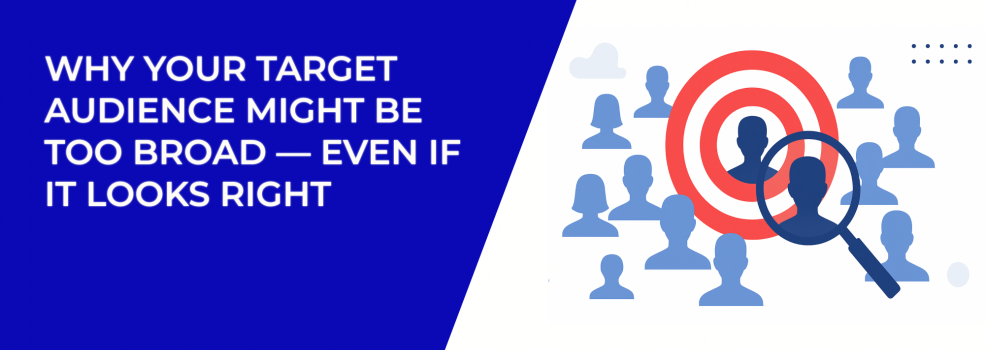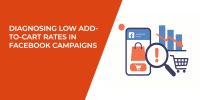When your Facebook Ads dashboard shows a potential reach in the millions, it feels like you’ve struck gold. But here’s the problem: a big audience isn’t always a good audience. Many advertisers confuse size with relevance — and that’s where ad budgets start to vanish without a trace.
So, how do you know when your target audience is too broad, even if it seems perfectly aligned with your offer? Let’s break it down.
1. The Comfort Trap of “Looks Right” Targeting
It’s easy to assume your targeting is spot-on when your audience includes people who could be interested in what you sell. But “could be” is not the same as “likely to be.”
Imagine you’re selling premium coffee subscriptions. You target “coffee lovers” aged 18–65, nationwide. Sure, you’re hitting coffee drinkers — but that includes everyone from college students who can’t afford your product to people who just buy the cheapest instant coffee at the supermarket.
The trap? Broad categories often hide the fact that your ads are reaching a lot of people who have no reason to convert. And when that happens, you’re paying for impressions that will never turn into sales.
Tip: Look for audience segments with both interest and intent. The overlap is where the conversion magic happens.
If you want a quick refresher on the fundamentals, our guide on Facebook Ad Targeting 101 walks you through the core principles of reaching the right audience from the start.
2. High Reach, Low Action — A Classic Red Flag
You might be hitting hundreds of thousands of users, yet your click-through rate stays low. That’s a signal.
If your audience is too broad, your ad relevance score will suffer. Facebook’s algorithm will try to “guess” who inside that huge pool might respond, but it will also spend a chunk of your budget on random, low-interest viewers just to test.
This is why you can have thousands of impressions but barely any link clicks. Your message is simply too diluted for the majority of the people seeing it.
How to spot it quickly:
-
CTR below your industry benchmark.
-
High CPM with no proportional rise in conversions.
-
Engagement mostly from irrelevant users.
When you see these warning signs, it’s time to rethink your audience targeting before more of your budget slips away unnoticed.
3. Overlapping Audiences Can Create Hidden Waste
Many marketers run multiple ad sets without realizing they’re targeting the same people in slightly different ways. This audience overlap can make your targeting feel broad when, in reality, you’re paying to reach the same individuals more than once — and not in the good “remarketing” way.
If Facebook detects too much overlap, it may put your campaigns into a kind of silent competition, driving up your costs and lowering delivery efficiency.
Quick fix: Use Facebook’s Audience Overlap tool. If you see more than 30–40% overlap between ad sets, consider merging them or refining targeting to keep segments distinct.
We break down how to spot, measure, and fix this issue in our full article on audience overlap in Facebook Ads.
4. Interest-Based Targeting Has Its Limits
Interests can be vague, outdated, or misleading. Someone might have “liked” a relevant page five years ago but hasn’t engaged with similar content since. Facebook still counts them as interested, but in reality, they’re cold traffic.
Instead of relying purely on interest-based targeting, layer your audiences:
-
Combine interests with behavioral signals (e.g., online buyers, frequent travelers).
-
Narrow by demographics that truly match your ideal buyer profile.
-
Add lookalike audiences based on your best-performing customers.
If you want to go even further, tools like LeadEnforce can give you an edge by letting you target people who actually follow specific Facebook groups and Instagram pages. This means you’re not just relying on Facebook’s interpretation of “interests” — you’re reaching users who are actively connected to communities, brands, or topics closely related to your offer. It’s a powerful way to shrink your audience to the ones who matter most, without losing precision.
Want to learn more about this strategy? Check out our guide on how to build your target audience from a Facebook group for a step-by-step approach. It’s a powerful way to shrink your audience to the ones who matter most, without losing precision.
5. Relevance Beats Volume Every Time
Think about it — would you rather have 10,000 people in your audience with a 5% conversion rate or 100,000 with a 0.5% rate? The smaller group could bring in far more actual customers for the same budget.
A targeted, refined audience makes it easier for your messaging to hit home. It also improves Facebook’s machine learning, letting the platform find and serve ads to people most likely to take action.
When you focus on relevance, you’re not just cutting wasted spend. You’re also improving your ad quality score, which can lower your costs over time.
We’ve also compared the pros and cons in Retargeting vs. Broad Targeting so you can choose the approach that fits your goals.
6. How to Shrink Your Audience Without Killing Potential
If you suspect your targeting is too broad, here’s how to tighten it without losing valuable reach:
-
Define your buyer persona in detail — not just age and location, but buying triggers, lifestyle, and specific needs.
-
Use exclusion targeting to remove groups that may fit the basic profile but have low purchase intent.
-
Prioritize warm audiences before expanding to cold ones — these are users who have already engaged with your brand.
-
Run A/B tests with narrower variations to see which segment delivers better ROAS.
Final Thoughts
Broad targeting can look impressive on paper. But the truth is, the more refined your audience, the more your ad spend works for you.
If you want better Facebook Ads performance in 2025 and beyond, trade vanity reach for meaningful reach. The right people, seeing the right message, at the right time — that’s what wins.

